|
|
|
Sort Order |
|
|
|
Items / Page
|
|
|
|
|
|
|
| Srl | Item |
| 1 |
ID:
154394
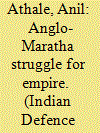

|
|
|
|
|
| Summary/Abstract |
At the beginning of the seventeeth century, power equations on the West coast had undergone a major change. The Siddi of Janjira, though undefeated and surviving, was much weakened due to the losses suffered by his patrons, the Mughals, in their war against the Marathas. The Portuguese were on the decline, holding on percariously to their possessions in India by attempting to befriend the British. The Marathas and the British were thus the main powers left in the fray for the mastery of the Western coast. After Shivaji's death, while the Maratha were fully engaged in fighting the Mughals, the Maratha navy continued to grow thanks to a remarkable Maratha Admiral, Kanhoji Angre. The history of the Maratha navy is synonymous with the history of the Angres till the first half of the eighteenth century.
|
|
|
|
|
|
|
|
|
|
|
|
|
|
|
|
| 2 |
ID:
154359
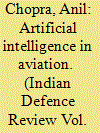

|
|
|
|
|
| Summary/Abstract |
Aviation is one of the most heavily regulated industries in the world due to safety reasons. Strict regulations have helped the avition industry provide the safest way the transport per mile travelled. Aviation incidents are few and far between, and are getting rarer every year. Some degrees of automation have indeed helped get aviation to where it currently is. But human control and intervention have always been at the heart of it. form pilots to Air Traffic Controllers. This is about to change.
|
|
|
|
|
|
|
|
|
|
|
|
|
|
|
|
| 3 |
ID:
154367
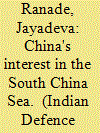

|
|
|
|
|
| Summary/Abstract |
China is the largest country in the region in terms of economic strength, military and land area, Since 2013, China has begun trying to alter the status quo in its neighbourhood, views the new US administrations policies as intended to retard its ambitions. While China's responses have been measured and deliberate, it has made clear it will not yield sovereignty over the South China sea. China has built airstrips and more recently, missile emplacements on the islands in the South China Sea, moved missiles to Hainan and in late February 2017, announced that it is constructing environment monitoring stations on the Scarborough Reef.
|
|
|
|
|
|
|
|
|
|
|
|
|
|
|
|
| 4 |
ID:
154354
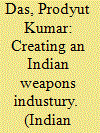

|
|
|
|
|
| Summary/Abstract |
The present fire and forget style of weapons development has not worked and will not work in hundred years. The development of weapons independence will need the active and sustained collaboration of the four constituents of the POBAT and that too in an atmosphere of mutual trust and respect.This, the cabinet must lead and ensure. Left to the politicians alone, they will ignore it till too late. Left solely to the bureaucracy, the threat will be downplayed in the name of looking for seeking diplomatic solutions. Quite understandably, the Armed Forces, acting alone, will over prepare for a worst possible scenario. The solution would be unaffordable and unsustainable. Left to the technocrats, we will have we shall a technical chaos - an enjoyable technical picnic but too aften very little by way of timely hardware in service.
|
|
|
|
|
|
|
|
|
|
|
|
|
|
|
|
| 5 |
ID:
154389
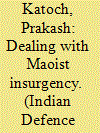

|
|
|
|
|
| Summary/Abstract |
Hundreds of CAPF battalions have been raised and there is no reason they cannot deal with internal security issues. They must perform/be made to perform, and most importantly, dominate the Dandakaranya forest, where on occasional foray and chest-thumping are useless, Surely, we need to look at a more integrated and deeper approach including MHA taking direct responsibility and control of counter-maoists operations rather than merely dishing out CAPF units to states; reorganising CRPF units in CI role on the lines of Rashtriya Rifles/Assam Rifles; discontinue the practice of imposing IPS officers on CRPF organisations; give the CRPF their own officers, review their training and imbibe the culture of officers leading troops in operations and ensure unity of command. The MHA must get into the acto rather than bureaucrats looking over the shoulder towards the Army, and help our enemies in getting the army sucked in here too.
|
|
|
|
|
|
|
|
|
|
|
|
|
|
|
|
| 6 |
ID:
154373


|
|
|
|
|
| Summary/Abstract |
The Corridor is, first and foremost, a vital investment for Beijing, which is slowly buying the strategic link, Beijing will soon control its new dominion, Pakistan. For India, it will be game changer as it will then directly face China on two fronts, the Northern and the Western. The Modi government should ponder about this.It is a new great but not easy game. What looks like a masterstroke on paper could turn into a nightmare for both China and Pakistan, unless India is taken onboard.But at a time Pakistan continues to fuel unrest in the Kashmir valley with the silent consent of China, how can Islamabad get New Delhi's blessings for such a gigantic project? Today, China and Pakistan may be gambling, but China has no choice but to understand India's concerns on this issue.
|
|
|
|
|
|
|
|
|
|
|
|
|
|
|
|
| 7 |
ID:
154275
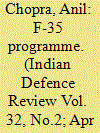

|
|
|
|
|
| Summary/Abstract |
The F-35 programme was being driven by a way professional team of uniformed and civilian members of the Pentagon. The Indian MoD needs to have such core ability and learn programme management. Public criticism of the Pentagon for the programme resulted in huge public and government pressure and in turn, aircraft improvements and cost cuts. President Trump himself has been a critic of the cost overruns and delays. Pentagon has no more money to pour into the programme after three costly restructurings in recent years. At one stage, there was a proposal to invite an open tender for all follow-on projects in the programme.
|
|
|
|
|
|
|
|
|
|
|
|
|
|
|
|
| 8 |
ID:
154282
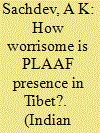

|
|
|
|
|
| Summary/Abstract |
The threat of co-ordinated action by China and Pakistan is a distinct possibility and, under such a scenario, the IAF would have to spread its assets on two fronts, that would render the PLAAF threat from Tibet even more worrisome. How worrisome would that threat be? The IAF is now posturing in the East to counter the PLAAF presence in Tibet. While the apparition of a two-front war does haunt the Indian psyche, there are counter arguments to suggest that in the event of a Chinese aggression a la 1962, Pakistan may be held back by international pressure led by the US, to desist from opening up another front.
|
|
|
|
|
|
|
|
|
|
|
|
|
|
|
|
| 9 |
ID:
154399
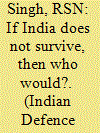

|
|
|
| 10 |
ID:
154348


|
|
|
|
|
| Summary/Abstract |
Swedish aircraft maker SAAB and US defence contractor Lockhed Martin are the runners-up in a fierce international competition to supply the Indian Air Force (IAF) with up to 250 new Western-made single-engine figher jet in the 2020s. Lockheed Martin has proposed to move its F-16 production line to Indian in accordance with Indian Prime Minister Narendra Modi's "Make in India"initiative. SAAB followed suit and pledged to set up its own aircraft production facility in India should the Gripen-E aircraft be selected.
|
|
|
|
|
|
|
|
|
|
|
|
|
|
|
|
| 11 |
ID:
154375
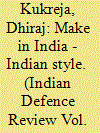

|
|
|
|
|
| Summary/Abstract |
The vibrant defence industrial base of DPSUs, OFs and R&S that has existed for decades has not produced the desired results; though there has been success in many fields, predominantly in space ventures, defence manufacturing is not one of them. A low plateau has been maintained in gaining self-reliance in defence production, the reasons for which are many. Can India usher in an era of transformation and self-reliance indefence production with the Prime Minister's call for make in India supported by the introduction of new policies, thus leading to a shift in focus from being import-dependent to a global exporter in its own right? the answers to this and other questions can be found only if all facets of the problem are examined.
|
|
|
|
|
|
|
|
|
|
|
|
|
|
|
|
| 12 |
ID:
154287
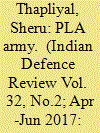

|
|
|
|
|
| Summary/Abstract |
The Chinese have long realised that technology is the cutting edge in modern combat. Accordingly, China has embarked on an ambitious programme to revamp its technological capability and this process is likely to take between fifteen to twenty years. Evidence suggests the PLA is engaged in a sustained effort to interdict, at long ranges, aircraft carrier and expeditionary strike groups that might deploy in the Western Pacific Following the experience of US intervention with Carrier Battle Groups during the 1995 and 1996 Taiwan Strait Crises, evidence suggests the Chinese military has invested in research, development, and technology acquisition oriented on anti-carrier operations. Similarly, China's placement of long-range SAM systems capable of providing coverage over Taiwan's airspace, combined with expansion of SRBM and amphibious forces, has introduced a destabilising capability.
|
|
|
|
|
|
|
|
|
|
|
|
|
|
|
|
| 13 |
ID:
154349
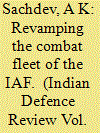

|
|
|
|
|
| Summary/Abstract |
In the absence of any indigenously produced combat aircraft discounting the non-operational Tejos, India's current aircraft are Russian (MiG-2, MiG-27, MiG-29, Su-30MKI), French (Mirage-2000) and the Anglo-French Jaguar. The IAF has learnt, nay mastered, the art of managing mixed fleets, even integrating Western and Indian avionics into Russian aircraft, but HAL has remained at the lowest point of the learning curve in terms of producing its own combat aircraft design, Thus, in future too, the IAF appears destined to live with mixed fleet although some rearrangement is foreseeable. So what are our foreign options?
|
|
|
|
|
|
|
|
|
|
|
|
|
|
|
|
| 14 |
ID:
154382
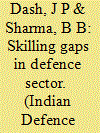

|
|
|
|
|
| Summary/Abstract |
India has the potential to emerge as a gobal platform for defence research, maufacturing and supply chain sourcing. With ambitious acquisition plans for modernisation, India has a historic opportunity, as the Modi Government has launched the Make in India initiative. The defence sector is one of the 25 sector which can propel manufacturing to new heights. May proactive steps such as change in DPP, Licensing norms, FDI limit have been taken. However, this sector to take off needs adequate and quality talent. India needs about 200, 000 skilled people in the defence and aerospace industry in ten years. For the Aerospace and Defence Industry, which works at the cutting edge of technology, availability of technical talent is becoming an acute challenge. There are serious structural gaps in the demand and supply of talent in this sector.
|
|
|
|
|
|
|
|
|
|
|
|
|
|
|
|
| 15 |
ID:
154271
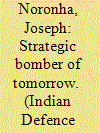

|
|
|
|
|
| Summary/Abstract |
Today, many nations have hundreds of multi-mission, flexible fighter aircraft on their inventory. And now that aerial refuelling has become the norm for most advanced air forces, including the IAF, a multirole fighter can match the range of a strategic bomber. The other major advantage the bomber holds over the figher that of far greater weapons load, has also been reduced to some extent with the widespread availability of PGMs. Any major air force that has aerial refuelling capability and specialist PGMs can undertake strategic missions without inducting and risking prohibitively expensive bomber aircraft such as the American B-2A spirit or the Russian PAK-DA. Therefore, it seems unlikely that other nations will be tempted to acquire or produce strategic bomber aircraft.
|
|
|
|
|
|
|
|
|
|
|
|
|
|
|
|
| 16 |
ID:
154280
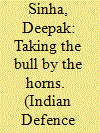

|
|
|
| 17 |
ID:
154268
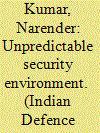

|
|
|
|
|
| Summary/Abstract |
The overall effort should be to enhance operational capabilities in an evolving security secenario. The Indian Armed Forces cannot remain immune even in changing times to serve narrow parachial bojectives. The integration and restructuring of the armed forces is warranted by the emerging security environment. In the backdrop of the above, the integrated command structure may be tri-services or even bi-services depending upon the nature of threat to India. It revolves around the mission and unity of command to fight a successful war and in turn, theatre battles. What is important is that decision time should be reduced and simultaneity of application of military force be achieved in a highly volatile and fast changing war scenario. The services need to keep national interests in mind rather than proecting their own turf.
|
|
|
|
|
|
|
|
|
|
|
|
|
|
|
|
| 18 |
ID:
154364


|
|
|
|
|
| Summary/Abstract |
The case of Wikileaks is an eye-opener for many reasons. It has shown how a great power responds when its might is challenged. Though in this case, the challenge was not thrown militarily, but through leaking its secrets which were treated as highly classified information. It does not matter for great powers that who, how or in which area their might has been challenged because great powers want to dominate in every field. They always want to be in control of the situation and that is why they are always suspicious about the intentions of anyone who tries doing anything which does not suit their interests.
|
|
|
|
|
|
|
|
|
|
|
|
|
|
|
|
|
|
|
|
|